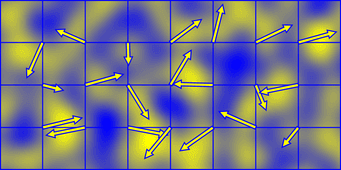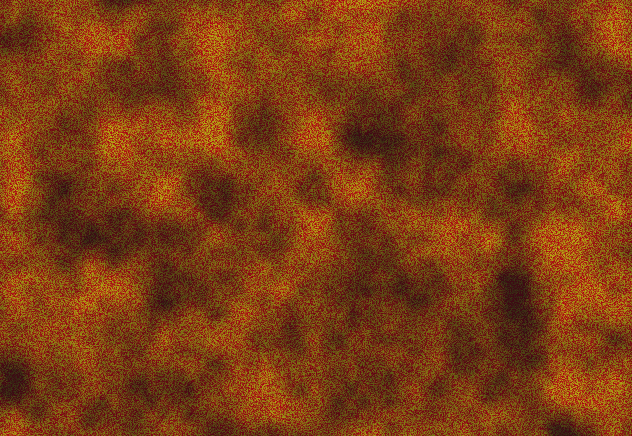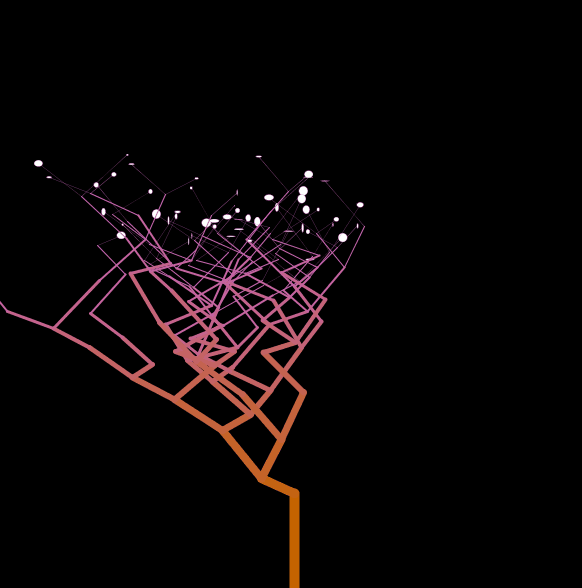概述
1.要求介绍
2.案例参考
3.作品拓展
一、要求介绍
针对《代码本色》第0章编写1个习作,需有不少于2个案例参考,且必须有一定的拓展。报告:写一篇文章,发表为博文/推文等形式,描述运用的规律,若用到了数学/物理/化学等学科中的知识,要用平实易懂的语言介绍原理,尝试运用凝练的数学语言表达(公式、方程、推导等),特别要描述出这些原理如何在作品中呈现的。
二、案例参考
1.案例参考一:均匀分布
(1)随机数的分布:均匀分布
了解Processing的随机数生成器产生的随机数。random()函数中取得的随机数并不是真正随机的,因此它们称为“伪随机数”。它们是由模拟随机的数学函数生成的。随着时间推移,这个函数将呈现出固定的模式,但那段时间很长,所以对我们来说,它的随机性已经足够了。
(2)相关代码:使用柱状图测试均匀分布
//随机数的分布
int [] randomCount;
void setup() {
size(640, 240);
randomCount=new int[20];
}
void draw() {
background(255);
int index=int(random(randomCount.length));//选择一个随机数,增加计数
randomCount[index]++;
stroke(0);
fill(127);
int w=width/randomCount.length;
for (int x=0; x<randomCount.length;x++) {
fill(random(125,255),random(0,255),random(125,255));
rect(x*w, height-randomCount[x]*5,w-1,randomCount[x]*5);
}
}
(3)效果展示

2.案例参考二:Perlin噪声
(1)Perlin噪声介绍:
由Ken Perlin发明的自然噪声生成算法 ,一个噪声函数基本上是一个种子随机发生器。它需要一个整数作为参数,然后根据这个参数返回一个随机数。如果你两次都传同一个参数进来,它就会产生两次相同的数。这条规律非常重要,否则柏林函数只是生成一堆垃圾。

(2)processing中关于Perlin噪声的使用
在Processing中使用noise()函数生成Perlin噪声,其中有一、二、三个参数可选,分别代表一维、二维、三维的噪声。

(2)相关代码:利用perlin噪声生成云彩
public void drawCloud() {
for (int x=0; x<width; x++) {
for (int y=0; y<height; y++) {
float n=noise(0.02*x, 0.02*y, 0.02*t)*255;
set(x, y, color(n));
}
}
(3)效果展示

三、作品拓展
(1)作品一:利用随机数生成树枝
- 效果展示

- 介绍
总体介绍:该作品由自定义的概率生成每一个树枝,树枝的生成利用了递归,之前尝试过每一个树枝给它定义过三个枝丫,但是那样子由于层级太多,导致生成的枝丫全堆积在了一起。于是设置了自定的概率,通过概率控制枝丫的个数,比如分支为一的概率为0.5,同时分支为一时,枝丫是向左分支还是向右分支的概率相等。分支为二的概率为0.3.分支为3的概率为0.2.这样子就可以将树枝的枝丫分割开来,能够实现比较好的效果。

- 代码展示
ArrayList<Twig> twig = new ArrayList<Twig>();//存放所有的树枝
int maxHight =10;//树的最大层级
void setup() {
size(600,600);
float rootLength = random(80.0, 150.0);
twig.add(new Twig(width/2, height, width/2, height-rootLength, 0));
///递归生成整个树
recursion(twig.get(0));
}
void draw() {
background(0);
for (int i = 0; i < twig.size(); i++) {
Twig branch = twig.get(i);
branch.drawTwig();
if(!branch.judgeLevel()){
ellipse(branch.end.x,branch.end.y,random(0,10),random(0,10));
}
}
}
int red=0;
void mouseClicked()
{
twig.clear();
float rootLength = random(80.0, 150.0);
twig.add(new Twig(width/2, height, width/2, height-rootLength, 0));
red=int(random(0,255));
recursion(twig.get(0));
}
////****************递归生成树枝******************
void recursion(Twig twigFather) {
ArrayList<Twig> sonTwig = new ArrayList<Twig>();//存放新生成的子树枝
PVector beginSon=twigFather.end;//子树枝的开始点
float probel=random(0,1);
if(probel<0.25){
sonTwig.add(new Twig(beginSon.x, beginSon.y, beginSon.x+random(20, 50), beginSon.y-random(10, 50), twigFather.level+1));
}else if (probel<0.5){
sonTwig.add(new Twig(beginSon.x, beginSon.y, beginSon.x-random(20, 50), beginSon.y-random(10, 50), twigFather.level+1));
}else if(probel<0.8){
sonTwig.add(new Twig(beginSon.x, beginSon.y, beginSon.x-random(20, 50), beginSon.y-random(10, 50), twigFather.level+1));
sonTwig.add(new Twig(beginSon.x, beginSon.y, beginSon.x+random(20, 20), beginSon.y-random(10, 50), twigFather.level+1));
}else{
sonTwig.add(new Twig(beginSon.x, beginSon.y, beginSon.x+random(20, 50), beginSon.y-random(10, 50), twigFather.level+1));
sonTwig.add(new Twig(beginSon.x, beginSon.y, beginSon.x-random(20, 50), beginSon.y-random(10, 50), twigFather.level+1));
}
// 将新生成的树枝加入总的树枝
for (Twig sonTwigone : sonTwig) {
twig.add(sonTwigone);
if (sonTwigone.level < maxHight) {
// 如果不是最大的深度,那么就继续生成树枝
recursion(sonTwigone);
}
}
}
//******************树枝类**********************
class Twig {
private PVector start;//树枝绘制的起点
private PVector end;//树枝绘制的终点
private int level;//树枝的层级
//**********构造函数***********
public Twig(float x1, float y1, float x2, float y2, int level) {
this.start=new PVector(x1, y1);
this.end=new PVector(x2, y2);
this.level=level;//树的层级
}
//**********绘制树枝***********
public void drawTwig() {
strokeWeight(10-level);
stroke(red,100,this.level*20);
line(start.x, start.y, end.x, end.y);
}
//**********判断层级是否小于最大层数***********
public boolean judgeLevel(){
if(this.level<maxHight)return true;
else return false;
}
}
(2)作品二:伪随机数之均匀分布实现油漆飞溅效果
-
流程展示

1.map:实现颜色的映射 -
代码展示
void setup() {
size(800, 500);
background(255);
}
void draw() {
}
//鼠标按下执行的操作
void mousePressed() {
drawManyCircle();
}
void drawManyCircle() {
pushMatrix();
translate(mouseX, mouseY);
fill(random(125, 255), random(255), random(255));
noStroke();
int circleNum = int(map(random(1), 0, 1, 400, 500));
//print(map(random(1), 0, 1, 700, 1000));
//循环生成很多大小不同的圆形
for (int i = 0; i < circleNum; i++) {
float diameter = random(1);
float dis = pow(random(1), 4);
//圆的半径控制在1—15大小范围内
//各个圆之间的距离控制在0—150的范围内
float circleDiameter = map(diameter, 0, 1.5, 1, 15);
float circleDistance = map(dis, 0, 1, 0, 150);
float radians = random(TWO_PI);
ellipse(circleDistance * sin(radians), circleDistance * cos(radians), circleDiameter, circleDiameter);
}
popMatrix();
}
- 效果展示

(3)作品三:使用Perlin噪声生成流动的冰淇淋
- 相关实现介绍:
- noiseDetail():noiseDetail以指定细节程度
- noiseSeed():指定噪声种子,同样的种子每次产生相同的噪声
- 使用一维Perlin噪声,使用两个参数的输入,一个输入与x有关,另一个输入与y有关。
- 代码展示
Perlin perlin1=new Perlin();
int t=0;
void setup()
{
size(350, 800, P3D);
noiseSeed(4);
noiseDetail(3);
}
void draw() {
++t;
perlin1.drawMoutain();
strokeWeight(4);
perlin1.drawLine();
}
class Perlin {
public Perlin() {
super();
}
public void drawMoutain() {
if (frameCount%20==0)stroke(random(125, 255), random(0, 255), random(125, 255));
for (float x=0; x<width; x++) {
float n=noise(0.015*x, 0.01*t)*(height/2);
line(x, 0, x, height/2-n);
}
}
public void drawLine(){
line(0,height/2,width/2,height);
line(width,height/2,width/2,height);
}
- 效果展示

